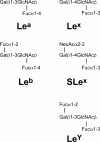Lipopolysaccharide modification in Gram-negative bacteria during chronic infection
- PMID: 27075488
- PMCID: PMC4931227
- DOI: 10.1093/femsre/fuw007
Lipopolysaccharide modification in Gram-negative bacteria during chronic infection
Abstract
The Gram-negative bacterial lipopolysaccharide (LPS) is a major component of the outer membrane that plays a key role in host-pathogen interactions with the innate immune system. During infection, bacteria are exposed to a host environment that is typically dominated by inflammatory cells and soluble factors, including antibiotics, which provide cues about regulation of gene expression. Bacterial adaptive changes including modulation of LPS synthesis and structure are a conserved theme in infections, irrespective of the type or bacteria or the site of infection. In general, these changes result in immune system evasion, persisting inflammation and increased antimicrobial resistance. Here, we review the modifications of LPS structure and biosynthetic pathways that occur upon adaptation of model opportunistic pathogens (Pseudomonas aeruginosa, Burkholderia cepacia complex bacteria, Helicobacter pylori and Salmonella enterica) to chronic infection in respiratory and gastrointestinal sites. We also discuss the molecular mechanisms of these variations and their role in the host-pathogen interaction.
Keywords: Burkholderia cenocepacia; Helicobacter pylori; O antigen; Pseudomonas aeruginosa; adaptive mutation; cystic fibrosis; gastric ulcer; lipid A.
© FEMS 2016. All rights reserved. For permissions, please e-mail: journals.permissions@oup.com.
Figures





Similar articles
-
Outer Membrane Lipid Secretion and the Innate Immune Response to Gram-Negative Bacteria.Infect Immun. 2020 Jun 22;88(7):e00920-19. doi: 10.1128/IAI.00920-19. Print 2020 Jun 22. Infect Immun. 2020. PMID: 32253250 Free PMC article. Review.
-
Bacterial sinusitis can be a focus for initial lung colonisation and chronic lung infection in patients with cystic fibrosis.J Cyst Fibros. 2013 Sep;12 Suppl 2:S1-20. doi: 10.1016/S1569-1993(13)00150-1. J Cyst Fibros. 2013. PMID: 24064077
-
Pulmonary Pathogens Adapt to Immune Signaling Metabolites in the Airway.Front Immunol. 2020 Mar 13;11:385. doi: 10.3389/fimmu.2020.00385. eCollection 2020. Front Immunol. 2020. PMID: 32231665 Free PMC article. Review.
-
New Mouse Model for Chronic Infections by Gram-Negative Bacteria Enabling the Study of Anti-Infective Efficacy and Host-Microbe Interactions.mBio. 2017 Feb 28;8(1):e00140-17. doi: 10.1128/mBio.00140-17. mBio. 2017. PMID: 28246361 Free PMC article.
-
Lipopolysaccharide structure impacts the entry kinetics of bacterial outer membrane vesicles into host cells.PLoS Pathog. 2017 Nov 29;13(11):e1006760. doi: 10.1371/journal.ppat.1006760. eCollection 2017 Nov. PLoS Pathog. 2017. PMID: 29186191 Free PMC article.
Cited by
-
Fetal growth restriction induced by maternal gal-3 deficiency is associated with altered gut-placenta axis.Cell Death Dis. 2024 Aug 8;15(8):575. doi: 10.1038/s41419-024-06962-6. Cell Death Dis. 2024. PMID: 39117607 Free PMC article.
-
Genetic and Phenotypic Analysis of Phage-Resistant Mutant Fitness Triggered by Phage-Host Interactions.Int J Mol Sci. 2023 Oct 26;24(21):15594. doi: 10.3390/ijms242115594. Int J Mol Sci. 2023. PMID: 37958578 Free PMC article.
-
Intestinal Alkaline Phosphatase Activity and Efficiency Are Altered in Severe COVID-19 Patients.Gastro Hep Adv. 2023 Jul 17;2(7):911-917. doi: 10.1016/j.gastha.2023.07.003. eCollection 2023. Gastro Hep Adv. 2023. PMID: 39130768 Free PMC article.
-
Serratia marcescens RamA Expression Is under PhoP-Dependent Control and Modulates Lipid A-Related Gene Transcription and Antibiotic Resistance Phenotypes.J Bacteriol. 2021 Jun 8;203(13):e0052320. doi: 10.1128/JB.00523-20. Epub 2021 Jun 8. J Bacteriol. 2021. PMID: 33927048 Free PMC article.
-
LncRNA MIAT suppresses inflammation in LPS-induced J774A.1 macrophages by promoting autophagy through miR-30a-5p/SOCS1 axi.Sci Rep. 2024 Sep 30;14(1):22608. doi: 10.1038/s41598-024-73607-1. Sci Rep. 2024. PMID: 39349964 Free PMC article.
References
-
- Aaron SD, Vandemheen KL, Ramotar K, et al. Infection with transmissible strains of Pseudomonas aeruginosa and clinical outcomes in adults with cystic fibrosis. JAMA. 2010;304:2145–53. - PubMed
-
- Aspinall GO, Monteiro MA, Pang H, et al. Lipopolysaccharide of the Helicobacter pylori type strain NCTC 11637 (ATCC 43504): structure of the O antigen chain and core oligosaccharide regions. Biochemistry. 1996;35:2489–97. - PubMed
-
- Azmuda N, Rahman MZ, Sultana M, et al. Evidence of interspecies O antigen gene cluster transfer between Shigella boydii 15 and Escherichia fergusonii. APMIS. 2012;120:959–66. - PubMed
Publication types
MeSH terms
Substances
LinkOut - more resources
Full Text Sources
Other Literature Sources

